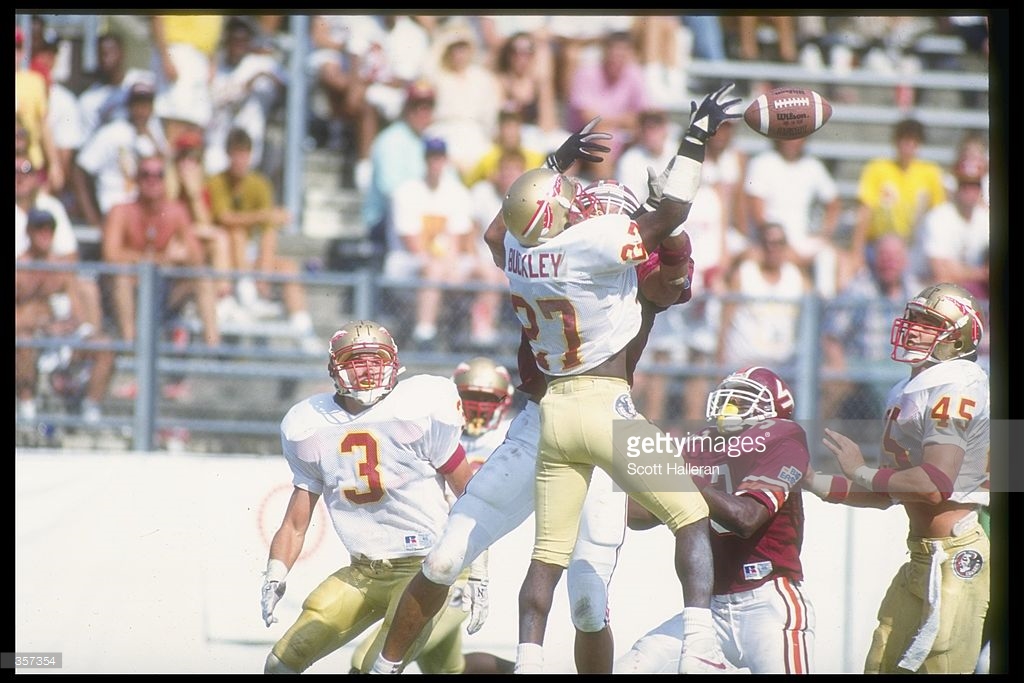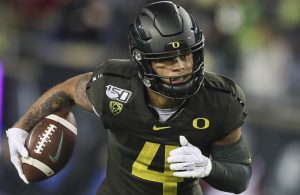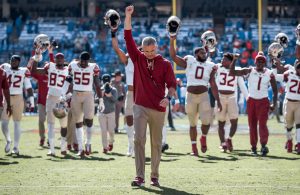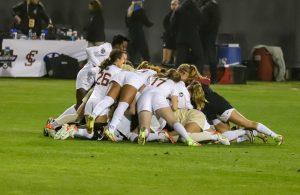- Sunday Seminole Summary: FSU Football Adds Pair of WR Transfers
- Sunday Seminole Summary: FSU Football Exits ESD With Top-15 Class
- Sunday Seminole Summary: FSU Soccer Tops BYU for Third National Championship
- Sunday Seminole Summary: FSU Soccer Advances to National Championship Match
- Seminole Sunday Summary: FSU Soccer Heads Back to College Cup
- Seminole Sunday Summary: FSU Soccer Reaches Sweet 16; Football Tops Boston College
- Seminole Sunday Summary: FSU Soccer Wins ACC, Advances to Second Round of NCAA Tournament; FSU Football Rallies Past Miami
- Seminole Sunday Summary: FSU Soccer Tops Wake on OT to Advance to ACC Final
- Seminole Sunday Summary: FSU Football Crushes UMass for Third Straight Win
- Seminole Sunday Summary: FSU Soccer Stays Perfect with Pair of Wins
Revisiting FSU’s Forgotten Heisman Contenders
- By Clint Eiland
- Updated: December 8, 2016
 Scott Halleran/Getty Images
Scott Halleran/Getty ImagesDalvin Cook will go down as the greatest running back in Florida State history, having broken almost every long-standing record set by those before him, but he will probably never visit New York for the Heisman Trophy ceremony.
For a second straight year, Cook was not invited despite having an argument for winning the award entirely. Many have regarded this as a snub, and it’s hard not to agree. Cook will still certainly receive votes at least. It’ll be interesting to see where he actually places at the end of it all.
When it comes to FSU players and Heisman Trophy ceremony snubs historically, Cook is not alone. FSU has a storied history with Heisman winners, which includes quarterbacks Charlie Ward, Chris Weinke, and Jameis Winston.
But what about the players who didn’t win it, yet were still in contention? These notable athletes are easier to forget, because their main career achievements typically don’t include “received votes for the Heisman”. As it turns out, Florida State has had numerous players (some famous, some not) that did finish in the top 10 of Heisman finalists.
We looked into those below and attempted to determine if they were under-ranked or over-ranked. Just in case you weren’t all that upset about Cook being left out, we’ve got a few others that might make you question the committee.
All numbers are from Sports Reference and Nolefan.org
1967 – Kim Hammond, QB (5th)
The first player from Florida State to ever receive Heisman votes, Hammond was the quarterback of a 7-2-2 Seminoles team that finished the season ranked 15th in the nation. His best games seemed to be the biggest ones. In his first ever start, Hammond threw for three touchdowns and 280 yards in a 37-37 tie against the No. 2 Alabama Crimson Tide, led by some coach named Bear Bryant.
Hammond also brought FSU its first win over the rival Florida Gators in Gainesville, throwing for two touchdowns and rushing for another in a 21-16 thriller. The Seminoles were rewarded with a Gator Bowl selection after rattling off seven straight victories to end the season. They played Penn State in a 17-17 tie where Hammond rewrote the record books with 37 pass completions for 362 yards and a touchdown (and four interceptions). Despite the turnovers, Hammond was named the game’s MVP. His final 1967 stat line was: 58 percent completion rate, 1,991 passing yards, 17 total touchdowns, and 10 interceptions.
Hammond finished below UCLA quarterback Gary Beban (eventual winner), USC running back O.J. Simpson, Purdue running back Leroy Keyes, and Syracuse running back Larry Csonka. While it is a bit far removed to complain about it, Hammond seems to have been yet another Florida State snub. He had more total yards than Beban (2,074 to 1,586) with two less total touchdowns (19 to 17) and nearly identical team records.
Heck, Hammond is in the top 10 of every single passing statistic for the 1967 season, something that Beban cannot claim. Both Simpson and Keyes have good arguments, but if the voters chose Beban over them, how did they ignore Hammond? Oh, the perks of being an established program.
Hammond would at least be properly recognized by Florida State. He was inducted into the FSU Hall of Fame in 1978, and worked as a judge in Flagler County for over 30 years. Another cool fact? Hammond was the first president of the “National Seminole Club” when the Seminole Boosters merged with the Alumni organization in 1972.
1968 – Ron Sellers, WR (10th)
Everyone knows just how good Ron Sellers was in college. Before passing was even popular, Sellers was putting up numbers that would look impressive for current receivers, much less ones in the 1960s. His 1968 season is the prime example of this.
Sellers amassed 86 receptions for 1,496 yards and 12 touchdowns, ranking No. 1 nationally in the first two categories and No. 2 in the last. He was named to a number of All-American teams and even received Heisman votes by the end of the year. Florida State went 8-3 that season and would play LSU in the Peach Bowl.
Sellers had over 200 receiving yards in four different games and never finished with fewer than 50. There’s a reason that his name is still near the top of FSU all-time statistical leaders, despite coming nearly 40 years before most of the competition.
As good as Sellers was, he finished 10th overall in a very deep Heisman class in 1968. USC’s O.J. Simpson was the dominant winner (855 first place votes) after gaining 1,880 yards and 23 touchdowns on the ground. Though some of the players Sellers finished below are certainly suspect — Penn State tight end Ted Kwalick finished fourth in the voting despite gaining only 403 receiving yards and two receiving touchdowns.
1972 – Gary Huff, QB (10th)
“Huff the Magic Dragon” was what we call today a “volume passer”. His senior season in 1972 would set passing records for Florida State that would not be surpassed until at least the 1990s by Danny Kanell. While the 1972 FSU football season was not especially notable (7-4 overall), Huff was still gaining national recognition with his aerial bombardment.
He had 385 attempts for 2,893 yards and a nation-leading 25 touchdowns. Unfortunately, that also includes 25 interceptions and a paltry 53 percent completion rate, but those were more acceptable in that era. Huff finished in the top 10 of six different passing/total yardage categories and threw for over 250 yards in five different games. Much like Sellers four years before him, Huff finished 10th in Heisman voting.
Also much like Sellers, while Huff probably didn’t deserve to win it (Nebraska’s Johnny Rodgers did) he certainly deserved better than 10th in the voting. Virginia Tech quarterback Don Strock finished one spot above him, and if you thought Huff had too many mistakes, get this: Strock had 16 passing touchdowns and 3,243 passing yards…but an ungodly 27 interceptions. It was the most in the nation and that was on an absurd (also nation-leading) 427 pass attempts.
Three more quarterbacks were voted above Huff: John Hufnagel of Penn State, Terry Davis of Alabama, and Bert Jones of LSU. Every single one finished below Huff in total yards, total touchdowns, and completion percentage. Hufnagel at least ranked No. 1 in passing efficiency rating, but it’s hard to see why any of them should have gotten more votes than Huff.
1979 – Ron Simmons, DT (9th)
The 1979 season was, in many ways, a turning point for the Florida State football program. The Seminoles went 11-1 with victories over both Miami and Florida on their way to an undefeated regular season. While they may have lost the Orange Bowl to Oklahoma, they were the first FSU team to ever finish a season ranked in the top 10, and they showed that the Seminoles were a sleeping giant in the college football landscape.
Coincidentally, they also had a giant on their defensive line with legendary defender Ron Simmons at nose guard. Simmons was, quite simply, magnificent. He totaled 81 tackles, 17 for loss, six sacks, two forced fumbles, and even two blocked kicks for a Seminoles defense that gave up more than 20 points just twice on the year — 23 against Miami and 21 against Cincinnati. He was recognized with a consensus All-American selection and a ninth place finish in Heisman voting, which was impressive for a defensive player at the time.
Simmons had the unfortunate luck of being in yet another insanely deep Heisman class. While USC running back Charles White won it by a fair margin, there were many a deserving candidate that year. Billy Sims of Oklahoma, Marc Wilson of BYU, and Art Schlichter of Ohio State are a few of the names that could have easily won the award with their performances.
The only player who almost certainly didn’t deserve to be above Simmons was Purdue quarterback Mark Herrman. He had 2,377 passing yards and 16 passing touchdowns, but with 19 interceptions. Every quarterback above him was much more impressive, and while numbers like those were nothing to scoff at in 1979, Simmons probably made a bigger impact on the defensive line.
Oddly enough, Simmons’ best case for the Heisman wasn’t in 1979. It was likely in his 1977 true freshman season. That year saw him rack up near unbelievable numbers of 128 total tackles, 13 for loss, 12 sacks, 13 forced fumbles (questionable), and another blocked kick. That season also produced a sub-par Heisman class, with Earl Campbell of Texas being the clear standout of the group. Included was Notre Dame defensive lineman Ross Browner, who was able to climb all the way to fifth place. Simmons would probably not have won it, but he almost certainly would have finished higher.
1984 – Greg Allen, RB (7th)
It might seem blasphemous, but after looking at Allen’s numbers and the competition in general…it’s fairly clear that his 1984 Heisman finish was motivated by career recognition. Nothing really stands out about the season from either Allen’s perspective or the team’s in general. FSU finished 7-3-2 on the year, losing to three out of the four ranked teams it played (though a 38-3 blowout of Miami certainly must have felt good at the time).
Allen did boast an impressive 7.3 yards per carry average, but he only had 971 rushing yards and eight touchdowns. He didn’t even finish in the top 10 of any of the major rushing categories besides the aforementioned per carry average. Every other player that finished in the top 10 of Heisman voting (which included Boston College quarterback Doug Flutie and Miami’s Bernie Kosar) had much better arguments.
If it’s any consolation, Allen’s 1983 season probably should have garnered him more attention. That year he had 200 attempts for 1,134 yards and 13 touchdowns on a still respectable 5.7 yards per carry. The Heisman finalists that year were a very top-heavy group of Mike Rozier of Nebraska, BYU’s Steve Young, Flutie, and Nebraska quarterback Turner Gill. Beyond that, it gets hazy. The remaining six contenders are largely interchangeable, and Allen has an argument for at least being included in the group.
1991 – Terrell Buckley, CB (8th)
Every FSU fan knows that Casey Weldon was the 1991 Heisman runner-up to Desmond Howard. Most FSU fans also know that Buckley was the Jim Thorpe award winner in the same season. But not as many know that Buckley actually received Heisman votes. In what would be one of the most talented FSU teams to never win a title, the 1991 Seminoles faced five ranked teams in the regular season.
Their two losses came at the end against No. 2 Miami and No. 5 Florida by a combined six points, but they capped off the year with a nice Cotton Bowl win over No. 9 Texas A&M. Buckley and his ball-hawking skills were a large part of a stout defense that did not give up more than 17 points in nine of its 13 games. He was able to nab a still-standing FSU record of 12 interceptions, with two of those being returned for touchdowns. In addition to the 238 kick return yards, Buckley contributed 36 tackles, one forced fumble, and 337 punt return yards.
Cornerbacks typically don’t even get recognized by Heisman voters unless they have offensive/special teams stats to back them up. While he had some punt return yards, Buckley was still almost exclusively a defensive player. The fact that he finished eighth place in voting with solely his defensive stats is pretty darn impressive.




You must be logged in to post a comment Login